What Investors Really Look For: Crafting a Pitch Deck That Gets Funded
Real Startup Tactics to Build a Pitch Deck That Gets Funded

In the high-stakes world of startup funding, your pitch deck is more than just a collection of slides—it’s your first impression, your story, and your startup’s sales pitch rolled into one, when investors are more data-driven and selective than ever, crafting a compelling pitch deck can make the difference between getting a term sheet—or getting ghosted.
This guide breaks down what investors really want, how to build a winning pitch deck slide-by-slide, and what common mistakes to avoid. Whether you're raising a pre-seed round or scaling toward Series A, this post will help you shape a deck that doesn't just inform—but convinces.
What is a Pitch Deck?

- A pitch deck is a concise, visual document utilized by startup founders or entrepreneurs to describe their business idea, product, or service to stakeholders, partners, or potential investors.
- The purpose of a pitch deck is to create interest and attract funding or investment. It is used as a tool to convey the essentials of a business, its market potential, and its growth prospects in brief.
- A pitch deck is a brief, graphical overview of a startup or business usually done for the reason of securing investors, partners, or other important stakeholders.
- It is also used as a marketing tool that speaks to the future of the company, projecting its growth and profitability.
- The deck can usually be utilized when presenting to prospective investors at meetings to seek funding or resources.
Why Does a Pitch Deck Matters?
In today’s fast-paced startup landscape, investors are flooded with decks — often dozens a day. Most don’t get past the first few slides.
To stand out, your pitch deck must:
- First Impressions Count: In a hyper-competitive funding environment, your deck often determines whether you get a meeting or not.
- Storytelling with Data: Pitch decks help you explain what problem you’re solving, how, and why now—with clarity and conviction.
- Investor Decision-Making: A well-designed pitch deck can directly lead to term sheets and capital commitments.
- Strategic Clarity: It forces founders to crystallize their vision, strategy, and milestones.
What is the purpose of the Pitch Deck ?
The function of a pitch deck is to give a brief, engaging summary of a business or startup to prospective investors, partners, or stakeholders and secure funding, support, or interest. Precisely, a pitch deck should:
- Capture Attention: Immediately capture the attention of prospective investors or partners by delivering the most interesting facets of the business in a simple and appealing manner.
- Describe the Problem and Solution: Clearly state the problem being addressed by the business and how the product or service uniquely and effectively solves it.
- Highlight Market Potential: Illustrate the size and expansion potential of the target market, demonstrating that there is substantial opportunity for the business to grow.
- Highlight the Business Model: Describe how the business will make money and generate revenue, so investors can see the financial potential of the venture.
- Provide Evidence of Progress: Demonstrate traction, milestones, or accomplishments the business has gained to date, including customer acquisition, partners, or early revenue.
- Outline the Team:Highlight the experience and expertise of the team, making sure investors know the business is in good hands.
- Present the Request for Funding: State specifically how much funding is required, why it's required, and how it will be utilized in order to accomplish the business objectives.
- Incite Interest in Continued Dialogue: The pitch deck must generate interest and stimulate further discussions or meetings, preferably resulting in investment or strategic partnerships.
Essentially, a pitch deck is an investment attraction tool and a means to engage stakeholders in the business vision through presenting vital information in a clear, organized format.
What Investors Really Want to See
Here’s a breakdown of the essential components that every serious investor is scanning for — and how to nail each one.
- Introduction (Elevator Pitch)
- Problem
- Solution
- Market Opportunity
- Business Model
- Go-To-Market Strategy
- Competitive Landscape
- Traction
- Financials
- The Team
- Funding Ask
- Vision/Exit Strategy
1. Introduction (Elevator Pitch)

- The introduction, often called the “elevator pitch,” is the gateway to your pitch deck and arguably the most important first impression you’ll make on an investor.
- It should be concise, powerful, and engaging.
- A brief, intriguing description of your startup that swiftly describes what your business does, for whom, and why it's important—usually in one or two sentences. It's intended to pique interest and make the investor want to continue listening or reading.
- This paragraph contains the startup's name, logo, tagline, and one-line description that clearly states the business in plain language.
- The most important thing here is clarity and impact—you need to be able to describe what your business does, who it is for, and why it's important in around 30 seconds.
- Don't use buzzwords or technical terms.
- This introduction should also bring in the central value proposition: what needs are you covering and how do you differ from others.
- If executed well, this section will engage with your audience and get them wanting more.
2. Problem
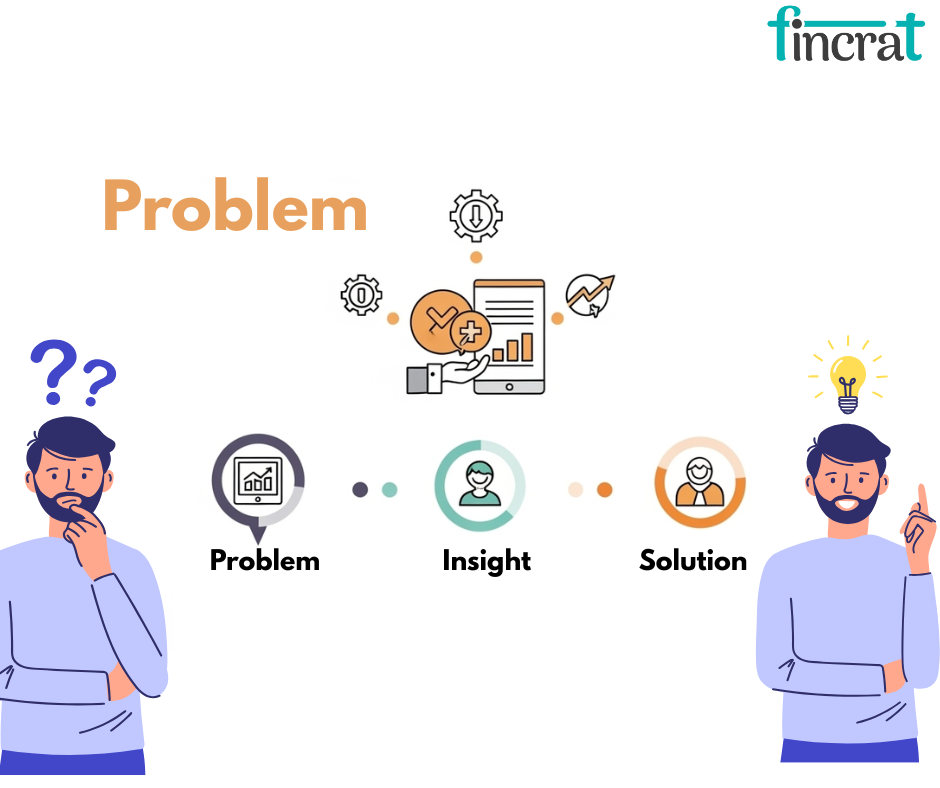
- A concise, one-sentence statement of the central issue your startup solves.
- It establishes who has the problem, how bad it is, and why current solutions don't work or don't exist.
- The problem section is in place to establish the problem your startup seeks to solve.
- Investors need to know first that there is a genuine, nagging problem in order to believe in your solution.
- Explain who the impacted customers or users are, what exactly frustrates or inefficiently serves them, and how many or how desperately this issue exists.
- Use facts, quotes, or anecdotes to make the impact clear.
- Make it relatable and personal—investors need to feel the issue, not merely read it.
- Explain if it's an issue people already attempt to address with bad solutions or if it's an unserved need.
- You can also underscore industry trends that enhance the salience of this issue over time.
3. Solution
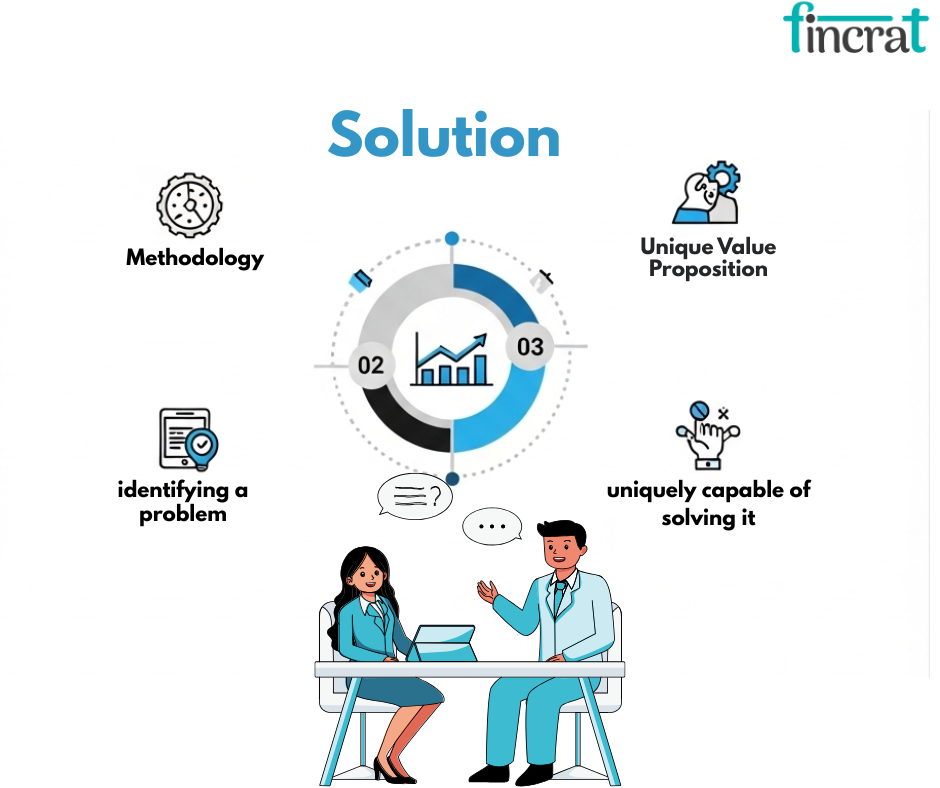
- Description of how your product or service successfully addresses the problem you've outlined.
- This section should emphasize key characteristics, advantages, and your distinct approach that sets you apart from others.
- Having set up the problem, articulate your solution in a way that is both rational and satisfying to the emotions.
- Describe how your service or product explicitly solves the pain point. Outline the key features, advantages, and results for users.
- Where feasible, provide visuals such as product images or use-case graphics to make your product tangible.
- How is your solution unique compared to what is already out there? This is where your Unique Value Proposition (UVP) comes in—it's the "why you" response.
- Mention your technology, methodology, design, or business model if they offer significant advantages.
- This section reassures investors that you’re not just identifying a problem, but are uniquely capable of solving it.
4. Market Opportunity

- An analysis of the size, growth potential, and dynamics of your target market.
- It shows investors that the business has room to grow and scale in a substantial market.
- This chapter illustrates the magnitude and scale of the opportunity for business.
- Large or rapidly growing markets attract investors as they imply scope for scalability and profitability.
- Supply market research that provides estimates of Total Addressable Market (TAM), Serviceable Available Market (SAM), and Serviceable Obtainable Market (SOM).
- Specify target customer segments, market trends, and industry growth rates.
- Use solid data sources, and if you're in an emerging industry or niche, say why it's going to grow.
- This section isn't about numbers—it's about possibility.
- Present a strong argument that your solution addresses a void in a worthwhile market that no one is filling well.
5. Business Model
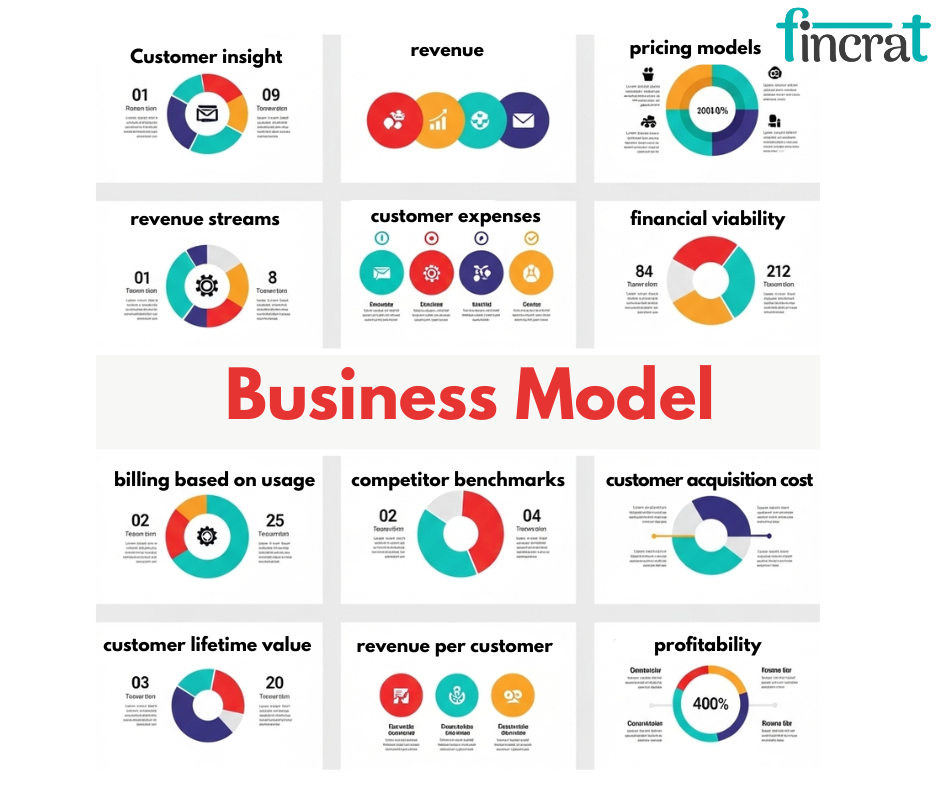
- An explanation of how your business generates revenue.
- It defines revenue streams, pricing models, customer acquisition expenses, and other monetization factors that demonstrate financial viability.
- Describe how your startup will monetize.
- Outline the revenue streams—customers will pay through subscription, one-time payment, billing based on usage, licensing, or advertising
- Give your pricing model and defend it in terms of market research or competitor benchmarks. Also mention how you will address customer acquisition cost (CAC), customer lifetime value (LTV), churn, and margins.
- If relevant, explain how you plan to upsell or grow revenue per customer. Early-stage financials should demonstrate a clear road to profitability, even if you're not yet profitable.
- This is all economics—how value gets from the customer to your bottom line.
6. Go-To-Market Strategy

- Go-to-market (GTM) strategy is your action plan for getting to customers and driving growth.
- Your action plan for getting, acquiring, and keeping customers.
- That involves marketing channels, sales strategies, partners, and distribution strategies customized for your target customers.
- It tells you how you'll be marketing, distributing, and selling your service or product.
- Specify the marketing channels you'll be using—search engine marketing, social media, influencer campaigns, email marketing, PR, events, etc.
- Describe your sales model (B2C, B2B, or channel sales), onboarding process, and customer support plan.
- Define any strategic partnerships that will help speed up distribution or credibility.
- The intent here is to show that you know your customer's buying habits and you have a solid strategy for acquiring, retaining, and scaling customers.
7. Competitive Landscape

- A summary of direct and indirect competition and how you stand among them. It describes what differentiates you and why you have a competitive edge in the market.
- In this subsection, you'll describe your competitors and tell us why your startup is superior.
- Investors are aware that all markets experience competition, even indirect.
- Plot your competitive positioning using a matrix or quadrant based on dimensions, such as price, performance, user value, or features.
- Next, explain your Unique Selling Proposition (USP)—what value do you have that no one else does? It may be technology, IP, customer service, speed to market, network effects, or operational efficiency.
- And, list barriers to entry: do you possess patents, exclusive arrangements, data benefits, or economies of scale? A thoughtful competitive analysis earns trust and demonstrates you've done your research.
8. Traction

- Traction is perhaps the strongest type of validation.
- It indicates that customers are already interacting with your product and that you're capable of delivery.
- Evidence that your startup is picking up speed and market validation.
- This may involve revenue, user growth, partnerships, testimonials, or successful pilot programs
- Add applicable metrics like user growth, revenue, retention rates, active users, partnerships, or even pilot program results.
- If you're in the early stage, report qualitative traction such as letters of intent, waitlist size, or feedback from beta users.
- Add graphs or charts that demonstrate upward momentum.
- This is your proof of concept and serves to de-risk investment in the investor's eyes.
9. Financials
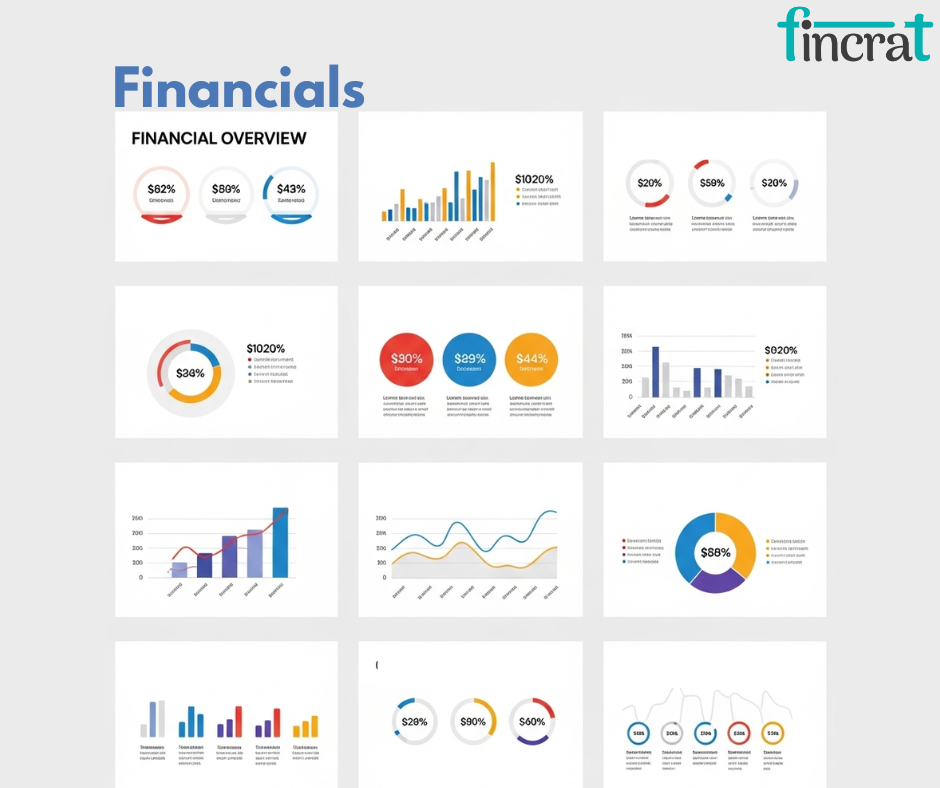
- A brief summary of current and future financial performance, revenue, expenses, profitability, and cash flow.
- Your funding requirements and key statistics such as burn rate and runway are also included in this section.
- Give a snapshot of where your finances stand today and projected finances for the next 3–5 years.
- Report revenue, COGS, gross margin, EBITDA, net income, and cash flow.
- Present your burn rate (monthly operating deficit), current runway (number of months before you require additional funding), and fundraising timeline.
- Investors will also like to view your assumptions—conversion rates, average transaction value, and growth rates.
- Though optimism is acceptable, your projections should be believable.
- If possible, add historical financials, especially if you're already generating revenue.
10. The Team

- Investors frequently claim to invest in people first. Take this opportunity to feature the founders and principal team members.
- A lineup of your startup's key team members, their job titles, and applicable experience.
- It emphasizes why your team is best suited to implement the business plan.
- Highlight past achievements, field expertise, and applicable industry or startup experience.
- Each member of the team should have a clear connection with the startup's strategic objectives.
- You can also add advisors or board members that bring credibility, connections, or expertise.
- The aim is to make investors believe your team has vision and operational capability to convert the idea into a thriving business.
11. Funding Ask
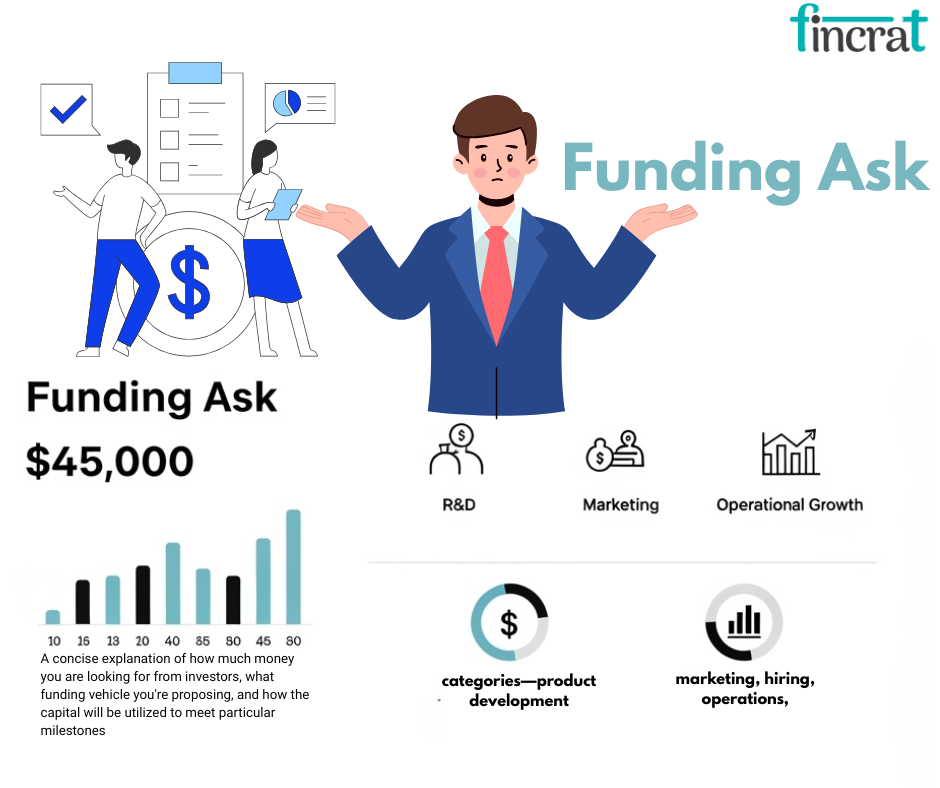
- A concise explanation of how much money you are looking for from investors, what funding vehicle you're proposing, and how the capital will be utilized to meet particular milestones.
- This portion describes how much funding you are looking for, what type of investment it is (e.g., equity, SAFE, convertible note), and what the funds will be used for.
- Categorize it into categories—product development, marketing, hiring, operations, etc.
- Describe how long the capital will last (runway) and what milestones you anticipate achieving with it (e.g., product launch, crossing $100k MRR, new market entry).
- Be specific, this transparency creates trust and demonstrates that you've given careful consideration to resource allocation.
12. Vision and Exit Strategy
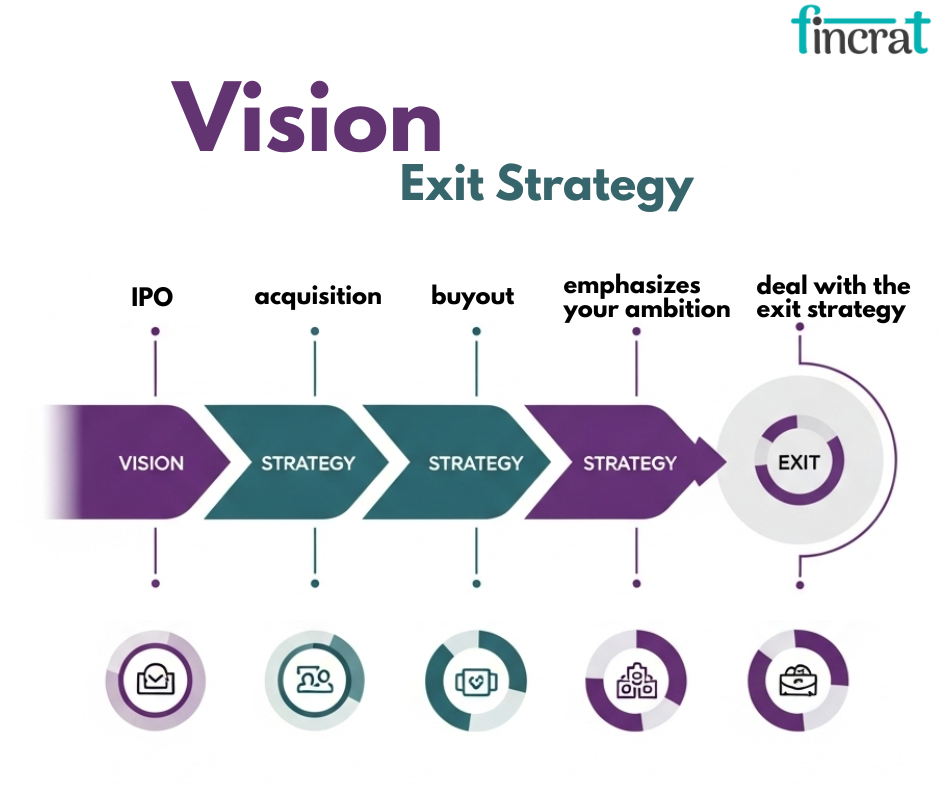
- Conclude your pitch with the big picture: where is your business headed? Paint your long-term vision in bold but reasonable terms.
- Your long-term strategy for the business and possible exit routes for investors. This might involve such strategies as acquisition, IPO, or buyout, and emphasizes your ambition and forward thinking.
- This might entail international market expansion, new product lines, or the redefinition of an industry.
- And deal with the exit strategy—how eventually the investors will receive a return.
- This might be through acquisition, IPO, or secondary sale.
- Though you can't see the future, a serious consideration of exit alternatives puts investors at ease knowing that you're creating a business with definite financial return.
Common Pitch Deck Mistakes to Avoid
1. Lack of Clarity in the Value Proposition
- One of the most common and fatal errors is failing to clearly communicate what your startup does and why it matters.
- If an investor can’t grasp your business in the first 60 seconds, you’ve likely lost them.
- Avoid vague statements like “We’re revolutionizing the digital space”—instead, be direct: "We help small businesses manage payroll 2x faster through an AI-powered app."
2. Too Much Text or Data Overload
- Pitch decks are meant to guide your verbal presentation, not duplicate your speech.
- Dense paragraphs, endless stats, or cluttered tables make your deck unreadable.
- Each slide should focus on one key point, use minimal text, and feature relevant visuals or infographics.
3. No Clear Problem Statement
- Investors want to know the pain point you’re solving.
- Most founders leap to the solution without clarifying the size, sense of urgency, or current frustrations of the problem in the market.
- Clearly describe whom this problem troubles, how frequently, and at what cost to them—emotional or monetary.
4. Ignoring or Downplaying Competition
- Declaring that we have no competition is a warning sign.
- All startups possess direct, indirect, or substitute competition.
- What investors are looking to see is your competitive edge—how your solution is superior, more affordable, quicker, or more scalable than what currently exists.
5. Dated or Tenuous Business Model
- A good pitch deck needs to describe how you monetize.
- Too many founders show an incredible product but don't demonstrate how it drives revenue.
- Insert pricing strategy, sources of revenue, and customer acquisition cost, particularly if you're looking for seed or Series A investment.
6. Unrealistic Financial Projections
- Assuming $100 million revenue in year three without making reasonable milestones or assumptions makes you appear gullible.
- Growth is what investors are looking for, but they want to be able to see reasonable, data-driven estimates.
- Insert simple financials: revenue, expenses, burn rate, and runway, and always indicate how you arrived at them.
7. Weak or Distracted Team Slide
- Investors invest in individuals as much as concepts.
- Don't just list names in a vacuum. Instead, emphasize pertinent experience, prior exits, industry expertise, or any distinct advantage your team has.
- If your team is missing something (such as a CTO), fill the hole and how you'll fill it.
8. Poor Go-to-Market Strategy
- "We'll go viral" or "we'll use social media" is not a strategy.
- Investors want to see specific channels, customer acquisition plans, partnerships, CAC (customer acquisition cost), and LTV (lifetime value).
- Your growth plan should be measurable and replicable.
9. Missing or Incomplete Traction
- If you’ve launched—even in a small beta—show it.
- Founders often miss the chance to share early wins like signups, revenue, retention rates, waitlist growth, or testimonials.
- Even pre-revenue metrics (like engagement or conversion rates) can establish validation.
10. Overloading with Product Features
- Founders tend to think too much about features rather than benefits.
- Investors do not require a live demo in a deck.
- Instead, illustrate what problem the product is solving and how it assists users.
- One clean screenshot with a brief description is more valuable than five technical wireframes.
11. Poor Visual Design
- Your deck is a reflection of your professionalism.
- Poor fonts, low-quality images, jumbled colors, or misaligned layouts leave a bad impression. Clean, branded visuals are the way to go.
- Applications such as Canva, Pitch, or PowerPoint using templates can enable even non-designers to present clean decks.
12. Omission of "The Ask"
- Most founders omit placing a clear, assertive funding ask towards the end. Always say:
- How much you are raising
- What it will be spent on (e.g., product development, hiring, marketing)
- What stage you are at (e.g., pre-seed, seed)
- Whether this is SAFE, equity, or convertible note
13. Not Demonstrating Exit Potential (For Growth-Stage Rounds)
- If you are raising a Series A or later, investors will want to understand how they are going to get their money back.
- Demonstrate potential exit opportunities such as acquisition targets, IPO, or secondary market sales.
- It demonstrates that you have considered the long term.
14. One-Size-Fits-All Deck
- Sending the same deck to various types of investors (e.g., SaaS-focused VCs vs. consumer-tech angels) is an error.
- Pivot your pitch to emphasize what each group is interested in: tech IP, market size, user growth, social impact, etc.
Wrapping Up: Your Deck Is a Door Opener
Your pitch deck isn’t just a slideshow — it’s the gateway to investor interest, funding conversations, and long-term startup growth. Think of it as your first handshake with potential backers: clear, confident, and compelling.
A well-crafted deck doesn’t guarantee funding, but it dramatically increases your odds of getting in the room, sparking curiosity, and starting serious conversations.
When tailored to what investors really look for — clarity, traction, vision, and returns — your deck becomes more than a presentation. It becomes a strategic tool that opens doors to capital and opportunity.
“Your pitch deck doesn’t close deals — it opens doors to them.”

